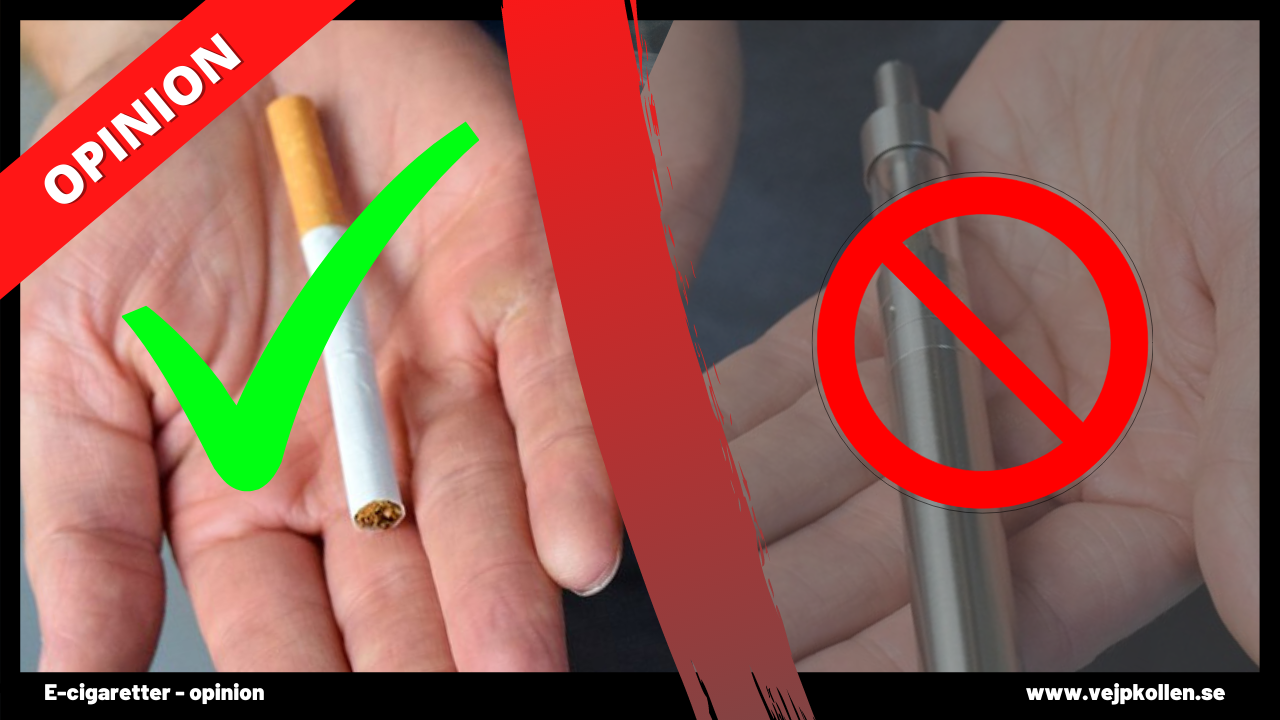12 000 Swedes die each year from smoking in Sweden. At the same time, the government and the Public Health Agency of Sweden want to severely limit smokers' ability to quit. They argue that harm reduction, with e-cigs and snus, is a myth. Why is it so? Vejpkollen asks.
This is a debating text. Do you think differently? Write in the comments section or send a reply to debatt@vejpkollen.se.
It is the smoke that kills the smoker. The combustion of tobacco. The glow. The temperature. The toxins produced when tobacco burns. Smokers get their nicotine by inhaling a cocktail of poisons. It may be tasty, but it is deadly.
In the same way that access to clean syringes for drug addicts decrease the damages of drug abuse, alternative nicotine products help smokers to avoid the harm of inhaling nicotine. It is about making a habit, an addiction, less harmful. Today, smokers can become smoke-free without giving up either nicotine or the pleasure of smoking.
And it should be easy. After all, it is a matter of life and death. Harm reduction for smokers is not just a ploy to sell smoke-free products like snus and e-cigarettes. Even if effective harm reduction has that as a side effect. Harm minimisation is about the smoker's life. There is no "hidden" agenda here. And the fact that some companies want to make money from smokers wanting or needing to quit is neither strange nor new.
The war on smokers
Because everyone wants to make money from nicotine, and nicotine sells.
At present, the tobacco companies (with snuff and nicotine pouches) and pharmaceutical companies (with nicotine medicines and the good will of the state) have the most market share, i.e. 'customers' who want to stop smoking. E-cigarette companies are also fighting, albeit on a smaller scale and with fewer resources.
You can think what you want about this, but at the end of the day there is really only one winner in this war. it is the smoker. Giving a smoker more opportunities to opt out of cigarettes in favour of less harmful products can have enormous consequences, not only for the individual, but also for the people around the smoker and for future generations. When cigarettes mean 'death and misery', the alternatives mean 'life and opportunity'. That's just the way it is.
Options and alternatives
Effective harm reduction must offer the smoker functional tools and good incentives to give up cigarettes. It is about attracting rather than penalising. A harm reduction alternative must therefore be more attractive than the 'original'. This is why e-cigarettes, nicotine pouches (and nicotine gum) can taste like candy, fruit OR tobacco. Not to attract non-smokers or curious young people. It's about persuading smokers to CHOOSE the alternatives. And that taste buds are different, even among smokers. And it works. It is a growing market solution to a huge public health problem.
Smokers are considered scum
This is a difficult nut to crack for our traditional health organisations. You know, the ones that for decades have freely devoted themselves to fighting the tobacco companies, stigmatising smokers, mobilising the whole of society against smokers, portraying smokers as undesirable elements and a burden to us all. They have been able to say more or less anything about smoking, tobacco companies and smokers without anyone questioning them.
The tobacco industry has behaved badly enough from a historical perspective to absolve their antagonists of responsibility and the anti-tobacco lobby's message has guided policy: smoking is the devil's invention, smokers have chosen 'sin' and smokers should be eradicated along with the tobacco companies. Over time, smokers have become so de-normalised that their existence is seen as downright provocative. Smoke-free is a nice word. To be a smoker is to be strange - abnormal.

Giving smokers human dignity
Harm reduction is fundamentally about restoring a kind of human dignity. It is about reaching the smoker, but more importantly, it is about listening on the smoker - ask the questions: "What do you WANT and what do you NEED?"
The problem, and it is becoming increasingly apparent that this is precisely the problem, is that a harm reduction strategy gives the smoker, and the hence the smoking, a kind of affirmation. A harm reduction philosophy actually recognises that smoking is a positive experience, at least for the smoker. That the smoker actually thinks that smoking offers benefits, that it is a pleasure and a social tool, not just a scourge. It is about the realisation that nicotine has positive effects for the smoker, even though it is addictive, that smokers smoke because they like itdespite the risk of death.
It is about nuance. Not stigmatising. It is about understanding, not rejecting.
Harm reduction products give smoking a boost a value by challenge that very value. By being better.
Challenging on all levels
And this can't stand it established tobacco control system.
It is based on the attitude that smoking is like a plague and should be avoided. treated as a disease. Smokers are seen as addicts - resulting in stigmatisation. According to this model, smokers are victims of greedy tobacco companies, sick, a bit stupid and in need of care - whether they want it or not.
There is an air of exclusion and contempt throughout. Misunderstanding and bullying.
That smoking has any direct value to the smoker does not fit into that equation.
"Hands on the duvet"
"But how else can we protect young people? We need to show them clearly that smoking and nicotine have no benefits whatsoever. They get brain damage from nicotine and just want more" screams today's most respected anti-tobacco activists.
The message from our beloved health organisations is reminiscent of when religious fanatics once claimed that masturbation was directly harmful to the brain. The solution was the threat of hell and catechism. "Hands on the duvet!"
The children got a very distorted view of reality. And of course they became very curious, because pleasure is attractive, even if it is "dangerous". Even if you become a masturbator. Or a smoker. In secret, if necessary.

"Fine medical products"
I think about it when I listen to Tobaksfakta's four-hour seminar in Almedalen (Sweden) about how they want to protect children from new nicotine products, focusing on e-cigarettes, snus and nicotine pouches. Each speaker consistently uses harm reduction as a dirty word, something the tobacco companies have invented. That e-cigarettes and snus are less harmful than smoking tobacco is called a myth. The fact that new nicotine products are replacing smoking among young people is seen as a threat, an obstacle to 'progress'. A sign of the innovative greed of tobacco companies - a challenge!
Curing smokers
According to the Public Health Agency, smoking cessation is a medical project. Something that is already addressed by "proven" medicines. Smokers do not need alternatives to smoking tobacco. They need health care.
"There are many great smoking cessation products that are medical in nature that you can use to quit smoking" says Josefin P. Jonsson, Head of Unit at the Public Health Agency of Sweden, in his presentation for Tobacco Facts in Almedalen.
Medicines are not up to scratch
The public health authorities' version of the catechism is of course nicotine patches, nicotine gum and psychotropic drugs such as Champix.
"Fine products" Really?
According to a review of randomised control trials in the British Cochrane systematic reviews these products, in combination with interventions, have an effectiveness of 5 to 10%. 1 in 10 quit smoking with the help of nicotine patches and similar products. Fewer as time goes on.
What if alvedone only helped one in ten people get rid of their pain? Would that product even be on the shelves? No, probably not. But Nicorette is a billion-dollar seller. Perhaps because every single doctor recommends it, with the help of the advice of the public health authorities?
E-cigarettes are twice as effective
E-cigarettes, on the other hand, have a efficiency of almost 20 per cent, according to Cochrane. With few direct side effects other than transient coughing, and a significantly lower cost to the user compared to patches, champix and therapy. E-cigarettes are also popular among UK smokers, and are used in one in three quit attempts. The corresponding popularity figures for other smoking cessation products are less than 10 per cent. 1.6 per cent of smokers prefer Champix.
Meanwhile, British studies show that nearly two-thirds of the country's 3.6 million road users are ex-smokers.
This is, if anything, a sign of effective smoking cessation. Or rather, harm reduction. The health risks of using e-cigarettes are, according to the Department of Health, 5 per cent of risks compared to smoking. The authority assesses that harm reduction programmes for smokers can reduce mortality among smokers in the country dramatically.
The myth of tobacco control
But all this is just a "myth" according to the Public Health Agency. Despite the fact that the sender is corresponding authority in one of the most respected countries in the world for tobacco control.
The truth is that it must remain a "myth". Otherwise the entire Swedish tobacco control system will collapse like a house of cards. If smoking is reduced due to alternative, less harmful sources of nicotine, the basis for funding organisations such as the Swedish Tobacco Control Agency will disappear. Doctors Against Tobacco, Psychologists against tobacco, We who do not smoke, Non smoking generation and their joint think tank Tobacco facts.
Effective harm reduction is a direct threat to their activities, those who annually receives millions from government money allocated by the public health authorities to combat smoking. It is no coincidence that these organisations now choose to highlight a new "threat" to fight. It is no longer about saving the lives of smokers, it is about saving a system from which they benefit. It is about their jobs and credibility, not about the greed of tobacco companies or the search for new customers.

Parliament wants to investigate injury risks
If smokers, or would-be smokers, young and old, choose to use e-cigarettes and other alternative nicotine products instead of cigarettes, there is a public health benefit. There is no doubt about that. The risks of nicotine are not unknown, they are in fact the basis of our traditional nicotine medicines, and they are acceptable risks. The harmful effects of smoking, on the other hand, are so great and well known that they must at least form the basis of a comparison between the alternatives. Anything else will be unethical. This is also recognised by a majority in the Swedish parliament.
Much to the chagrin of the public health authorities.
Public health agency wants a ban on flavours
According to the public health authority, a comparison in harm risk between different nicotine products is 'unnecessary' reveals Josefin P. Jonsson in Almedalen.
The myth must remain a myth. Otherwise, as I said, the whole house of cards will fall. Instead, they continue to pursue the issue of limit the supply of e-cigarettes and other nicotine products. With more fervour than before.
This became apparent during seminar in Almedalen that the Public Health Agency of Sweden has already taken a position in favour of the comprehensive ban on e-liquid flavours proposed by the government investigators in Sweden. Only tobacco flavours will be allowed (whatever that is). This is a ban that will greatly reduce the incentive for smokers to even consider smoking. trade the cancer sticks for a good e-cigarette. And yes, young people, which is always in the line of fire, will likely to smoke more instead. The majority of people who have ever used a weather product, smoke even before they try an e-cig. Why change if it doesn't taste better?
Order restored
But in this way, order is restored. The smoker no longer has access to competitive alternatives and can return to his or her place as a "patient". The children are encouraged to keep their hands on the duvet (and sneak smokes instead). Pharmaceutical companies remain the "saviour" with their obviously substandard and fundamentally undesirable products as the only option on the market. Tobacco companies can continue to sell their cigarettes, while the small companies dedicated to enticing smokers to quit using e-cigarettes will disappear altogether (their sales remain at 90 per cent of e-juice that tastes other than tobacco - they WILL go out of business).
12 000 die every year
If our authorities continue along the same lines, cheered on by their allies in the form of state-funded lobby groups, smokers will continue to die. At a rate of about 12,000 a year. Almost the same number that succumbed to COVID-19 in 2020-2021.
Fixed. Each. Year.
Is that what we want?
Stefan Mathisson
Editor-in-Chief Vejpkollen
And former smokers who now vape





This is a completely absurd position.
This parallel may shed some light on the subject.
Mp is against us driving a car.
How would we react if a ban on seat belts, airbags and crumple zones was introduced to make driving unsafe and to stop driving.